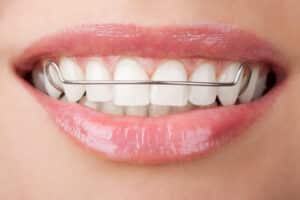Care Following Orthodontics – Retainers

At South Bay Dentistry, our team of orthodontists in Gardena is dedicated to helping you achieve a radiant and confident smile with our top-notch orthodontic retainers. Say goodbye to orthodontic worries and hello to a beautiful, long-lasting smile with South Bay Dentistry! Contact us today to schedule a consultation.
Why retainers?
After braces are removed, most people go into a retention phase, with the goal of preventing teeth from regressing back to their previous position. The objective of this phase is to ensure that teeth don’t regress back to their previous position.
A retainer can help maintain improvements made to the position of your teeth. Basically, a retainer is a dental appliance, which has been custom-made by an orthodontist and fits tightly in your mouth to help you maintain those improvements.
Retainers are generally made from plastic and wires, which are invisible and optimized for comfort. Your orthodontist’s objective is to make a custom-made retainer for your comfort after your braces are removed.
Various types of retainers are available, each requiring different wear schedules based on the treatment. It’s crucial to follow the orthodontist’s recommendation regarding the duration of retainer wear. In certain cases, wearing the retainer for a few hours a day might be sufficient to maintain the desired results. Trusting your orthodontist’s advice ensures the effectiveness of the treatment and helps you achieve a confident smile.
Successful treatment depends on how committed the patient is to wear their device as instructed. If the retainer falls out of place for any reason, it can cause the orthodontic treatment to fail or to take much longer than anticipated.
What types of retainer are available?
Retainers are a must-have for people with braces because they help keep their teeth stable. To treat different dental problems, different types of retainers are available. Consult your orthodontist or dentist to know which type of retainer will be suitable for you.
The following are some of the most common types of retainers:
- Hawley retainer – It is one of the most popular retainer designs. It is a metal wire that rests on an acrylic arch. The metal wire can be periodically adjusted by the orthodontist to ensure the teeth stay in the desired position. The acrylic arch is designed to fit comfortably on the lingual walls or palate of the mouth.
- Essix – There is one type of retainer that dominates the landscape; the Essix retainer. The Essix retainer is made by vacuum forming clear plastic over the teeth in their new alignment. It is then molded to fit the arch of the child’s mouth with clear PVC trays. Essex is a well-known vacuum-formed retainer (VFR).
- Fixed retainers – A fixed retaining bracket is a metal device that is affixed to a few teeth on the tooth’s lingual (tongue) side. It is usually used in cases of either rapid or substantial tooth movement in children and patients who are not able to wear removable appliances. A fixed retainer usually has a single wire.
One of the reasons that a fixed retainer is used is because teeth can move quickly, so placing a retainer to keep them in place is often a good idea. The inclination of teeth to move quickly also means they are likely to return to their previous position if a retainer isn’t placed.
What do I need to consider when using a retainer?
There are a few basic things to consider for proper use and maintenance of your retainer.
Don’t lose the appliance – Being removable, the retainers are very easy to lose. The best way to prevent this from happening is to place your retainer in its original case when eating, drinking, or brushing.
One of the most dangerous things is forgetting to leave your retainer at a restaurant or public restroom. If you ever lost it, it would be far more expensive to replace. Luckily, a brightly colored case serves as a great reminder.
Don’t drink while wearing a retainer – It’s tempting to drink while wearing a retainer because of how unobtrusive the device is. But with that comes the danger that any excess liquid that gets trapped under the tray will increase exposure to acid and make it much more likely that teeth will decay.
Don’t eat while wearing a retainer – Eating can be challenging with a retainer, and it can also damage the device. Food can get trapped on the wire or underneath the palate, causing bad breath. VFR retainers are worn on the upper and lower arches, so when they are tightened, the teeth are prevented from meeting. This means that chewing is difficult because there is no space for the teeth to join together.
Clean the retainer properly – Removable retainers are an excellent (and affordable) option for people with dental issues who can’t wear a fixed retainer. However, it’s important to clean the inside and outside thoroughly at least once a day. This can be achieved by using a toothbrush and mouthwash or denture cleaner. Hawley retainers should be cleaned with a toothbrush and mouthwash or denture cleaner.
If not cleaned regularly, the removable retainers can become breeding grounds for calculus and bacterial buildup.
VFR are made of PVC plastic can be damaged by harsh bristles, so a toothbrush or a specialized retainer cleaner is recommended for this type of device.
Wear the retainer as directed – This phase of treatment is crucial. The hard work is over; now it’s tempting to stop wearing the retainer as often as your orthodontist recommends. Retainers are needed to give the muscles and bones under the teeth time to stabilize so that the teeth in their new alignment can withstand chewing pressure from all angles.
If you don’t wear your retainer as instructed, you may experience regrettable consequences, such as your teeth returning to their original position, more dental visits and more costs.
If you have any questions or concerns about retainers, please contact our office.

